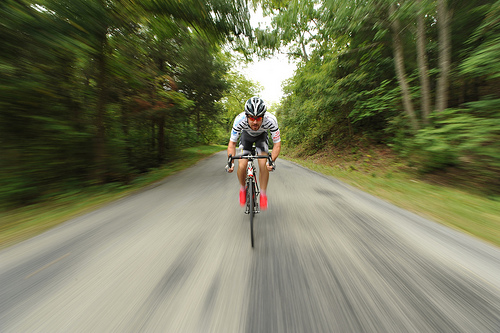Most cyclists want to be faster and stronger, but there is no one-size-fits-all way to get there. The general rule is to ride more, and ride smarter. Training plans can help you look at every aspect of your riding, and get you tackling those goals in a realistic way. However, time on the bike is not the whole picture of what it takes. Maintaining a healthy range of motion through stretching and strength training needs to be a key aspect of that plan. And no, we don’t mean doing a couple quad stretches before hopping on the bike–there’s more to it then that. So, how does stretching make you faster?

Does Stretching Make You Faster?
The cumulative effects of stretching (when done right) add up and in turn, can make you a faster and stronger cyclist. Here’s how:
Improved Flexibility
Each person’s body defines their own range of motion, there is no standard when dealing with a group of individuals. Your muscles are not in charge of your range of motion and flexibility, it is your bone and joint actions. So, when you stretch, it is actually the joint and ligaments being moved across these contact surfaces. Flexibility, or rather inflexibility, can lead to unbalance in the body, causing these structures to move out of alignment. Properly stretching and maintaining flexibility can not only affect you performance, but it is the most effective way to avoid injury.
Comfort on the Bike & Aerodynamics
Comfort on your bike has to do largely with your bike fit, but also your ability to maintain proper cycling posture. If certain muscles are tight, you’ll compensate in other areas of the body, which does nothing but harm. If you’re concerned with aerodynamics, then you should know that 80 percent of your aerodynamic drag is caused by your position on the bike. So, that $10,000 aero bike will only help you 20% of the way. For example, tight or shortened hamstrings will make the aerodynamic position impossible and tight calves can limit the power of your pedal strokes. Routine stretching will slowly improve your position and gift you a handful of free watts.
Injury Prevention
Due to the repetitive nature of the pedal stroke, cycling puts us in a particularly vulnerable situation. We spend hours hunched over the bars, spinning our legs at 100 revolutions per minute. The impact is low, but over time the muscular imbalances take a toll. Maintaining proper posture on your bike can go a long way to prevent injury. The natural inclination is to round your back as you crane your head to look forward. Not only does this create drag, but it will eventually cause pain in your lower and upper back and neck.
Everything in your body is connected. So, to maintain proper bike posture you have to have adequate flexibility in your lower back, hips, glutes, and hamstrings. The flatter your back can be, the less issues you’ll come up against in your training. Stretching is an easy thing to skip, but most cycling injury is caused by tight muscles. So, you could take ten minutes a day to stretch, or be off you bike for weeks at a time with an injury. Although stretching can be great treatment for certain injuries, it’s effectively too late. Better to avoid the injury in the first place by maintaining flexibility.
Stretching Done Right
Stretching is easy, but when done incorrectly it can actually slow you down. There’s no overnight fix, and it’s not just doing a couple stretches before hopping on your bike. That may have been what they taught you in high school, but it takes time and patience to reap the benefits of stretching.
Types of Stretching
- Dynamic – Dynamic stretching takes a joint or muscle through a range of motion. It is best done before cycling as a way to prepare the joints for the repetitive movement, get blood flowing and warm up your muscles.
- Static – Static stretches are designed to be held in one position for at least thirty seconds, and are what most people think of when it comes to stretching. The goal is to relax and lengthen the muscle and deepen the stretch bit by bit. This is best done after exercise, as static stretching before can actually hinder the muscle’s ability to fire.
When to Stretch
Just as you should do a warm up on your bike before hammering up a climb with everything you’ve got, so you need to warm up your muscles before stretching. This doesn’t mean you have to go for a full ride before doing your stretching routine, but it could be doing some jumping jacks, massaging the muscles, or walking around the block. Anything to get blood flowing to your muscles. If you do stretch cold muscles (but please don’t) ensure you are extremely gentle, slowly easing into a stretch.
Yoga and Cycling Speed
Yoga can be a great way to ensure you’re stretching on a regular basis, but too much of a good thing can be a bad thing. If you are doing more yoga and stretching then cycling, then you are working more on being pliable then being strong and powerful. Pliable muscles have to do more work to maintain the level of contraction needed for cycling. However, you would have to be doing excessive amounts for it to be any sort of detriment to your muscle power.
Although the understanding of the relation between stretching and athletic performance is still evolving, there are some facts that are standing the test of time. Dynamic stretching before a ride and moderate routine stretching off the bike can create the muscle pliability needed for you to be the strongest cyclist possible.
You don’t need to sign up for daily yoga classes or commit a ton of time to stretching, but even a little bit can go a long way in keeping you injury free and feeling your best. Start with 10 minutes a day, 4-5 times a week and you will start seeing and feeling the results. If you want a more intensive stretching program for cyclists, check out Dynamic Cyclist. They have daily, easy to follow stretching videos designed specifically for and by cyclists. Spend less time thinking about how and what to stretch, and more time in the saddle!